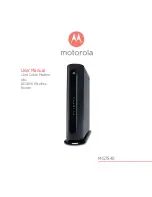
Chapter 6 – UDP Socket Services
Multi-Tech Systems, Inc. AT Commands for Wireless Modems with IP Connectivity (S000333D)
34
Chapter 6 – UDP Socket Services
Parameters Definitions
#UDPPORT UDP Port Number
Definition:
If the UDP session is initiated in listen mode, use the local UDP port number.
If the UDP session is initiated in active mode, use the remote UDP port number.
Values:
From 1 to 5 numeric digits (0 to 9).
Default is 0.
Notes:
•
Numbers above 65,535 are illegal as the port identification fields are 16-bits long in the IDP header.
•
Port number 0 is illegal.
Syntax:
Set Value:
AT#UDPPORT=<Value>
Get Value: AT#UDPPORT? or AT#VUDP, AT#VALL
#UDPSERV UDP Server
Definition:
If the UDP session is initiated in listen mode, use the IP address filter. This means that the remote must
have a defined UDPSERV IP address.
If the UDP session is initiated in active mode, use the remote IP address.
Note:
No IP filter is applied if the parameter value is
255.255.255.255
Values:
32-bit number is dotted-decimal notation (i.e., xxx.xxx.xxx.xxx) or
Alphanumeric ASCII text string up to 120 characters if DNS is integrated.
There
is
no default
value for this parameter.
Syntax:
Set Value:
AT#UDPSERV=<Value>
Get Value: AT#UDPSERV? or AT#VUDP, AT#VALL
#UDPTXDELAY UDP Data Delay
Definition:
This parameter determines the delay before sending an UDP datagram that has not been entirely filled
with user data. The delay is expressed in milliseconds.
The 0 value initiates the sending an UDP datagram as soon as possible after the reception of a single
character value from the host.
Values:
Integer, multiple of 20 and between 0 and 32760 inclusive.
Default value is 100.
Syntax:
Set Value:
AT#UDPTXDELAY=<Value>
Get Value: AT#UDPTXDELAY? or AT#VUDP, AT#VALL
















































